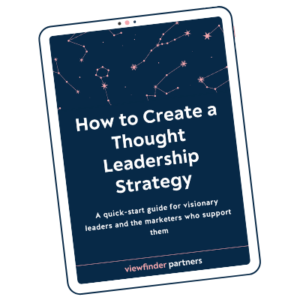What’s the big idea here?
^^ If you can’t answer that question, you may have lost the plot.
It’s incredibly common for marketing teams, report authors, and anyone who’s developing a complex idea to look up and realize they’ve strayed from the original message. In B2B, it’s easy to lose the plot, especially if:
- You’re presenting a big body of information, like new research.
- You have a lot of cooks (ahem, stakeholders) in the kitchen (ahem, shared doc).
- Your idea is bigger than one person, so you’ve added input and opinions from a broad swath of people at the company.
- You’ve been developing the idea for a long time, and the context around you has changed since you started.
When you reach this point, you can probably explain the general idea in 100 words, 1,000 words, or 10,000 words. (And I know you have a bloated PowerPoint deck you can send me.) But can you explain your idea in 10 words? In 5?
If you can’t, your audience surely can’t. It’s time to refocus, zoom in, and clarify. It’s time to reorient yourself around one big idea.
4 ways to zoom back in on your big idea
Start over with a clean slate.
If you’re drowning in words, maybe you don’t need to keep editing and refining. If you’re working in a doc that’s mostly red and crossed out—where you can’t tell what’s original and what’s a new suggestion—maybe it’s time to start over completely.
One of my favorite novelists, Lauren Groff, has shared her unconventional approach to writing: She writes a full first draft of a novel, longhand on paper…then puts it away in a box…and never.reads.it.again. 😮
Instead, she starts over, writing from memory, knowing that the most important parts will survive in her brain and come out again.
She describes her process in a New York Times interview:
“It’s not even the words on the page that accumulate, because I never look at them again, really, but the ideas and the characters start to take on gravity and density. […] Nothing matters except for these lightning bolts that I’ve discovered. […] Those are the only things that really matter from draft to draft.”
The lightning bolts! We’re all searching for the lightning bolts—the ideas and examples that are so good and so relevant that they will find their way back to us.
What would happen if you deleted everything you’ve collected about your big, convoluted, messy idea…and then started over from scratch? What lightning bolts would make themselves known?
Bounce ideas off someone new.
Here’s another strategy I recommend: Look for outside ears. Explain your idea to someone new. I find that two kinds of people are good listeners:
- People who know a lot about the topic. You could take the idea to a leader at your company who knows about the topic but hasn’t been involved in your message-making. What holes do they notice? What new questions do they introduce?
- People who know absolutely nothing about the topic. (This is usually where I come in.) When people aren’t bogged down by their own well-deserved biases and specific pockets of expertise, they can review an idea objectively. What stands out to them? What’s confusing? What’s repetitive? Do they know what any of it means?
One of the best questions I ask clients every day is, “What does that mean?” When someone has to explain their idea in simpler terms, they usually get clearer on what they’re actually trying to say…without hiding behind jargon or complicated diagrams.
Try talking it out.
Maybe you’re just bogged down in the digital clutter you’ve built around the idea. The other day, I found myself searching for a needle in a haystack. I was searching through client documents across three different screens. I was trying to piece together an impossible jigsaw puzzle, but I couldn’t find the thread connecting all the words they’d sent me.
So I went analog. I closed all the screens and asked to talk it out (like, on a literal phone call. Remember those?).
I find that when people ditch the written words and start TALKING about an idea off the cuff – no script or notes or spellcheck — the core of the idea emerges.
Finish this sentence: “The one thing I really want people to know is….”
At the end of the day, you’re not actually trying to publish a research report or write a speech or author an article. You’re trying to communicate something that people will remember. So what is that one thing?
What do you want people to know? What do you want to teach them? What do you want them to still be thinking about long after they hear your idea? How do you want your message to change their thinking or behavior?
When you’ve lost the plot, guide yourself back to the most essential thing you’re trying to communicate.
BONUS TIP: Once you’ve landed on your ONE BIG IDEA, write it at the top of every document and email. Make it your idea header, and keep every new piece of content in its orbit.
Here’s to everyone doing their best to ditch the wordy drafts, refocus their rambling thoughts, and get crystal clear about their big ideas.







